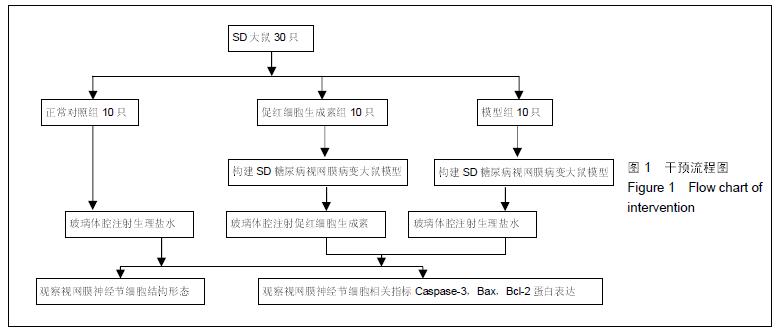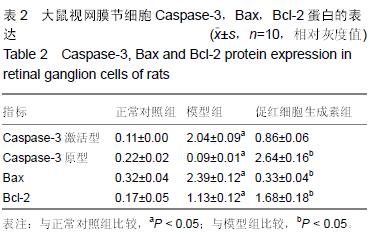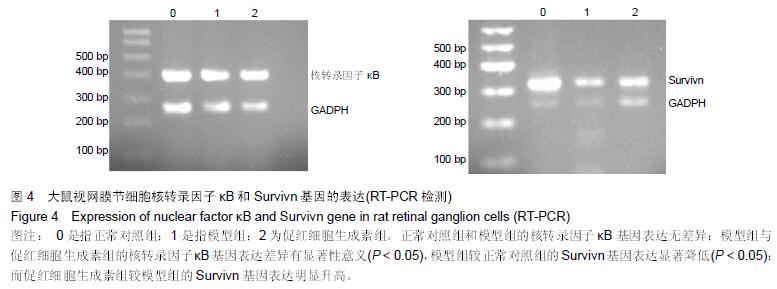| [1] 周玮琰,牛膺筠,周占宇,等.EPO对视网膜缺血再灌注损伤中WTp53、CyclinD1含量变化的影响[J].眼科新进展, 2007,27(10):738-741. [2] 解正高,陈放,庄朝荣,等.视网膜脱离模型中外源性促红细胞生成素对其受体表达的影响[J].眼科研究,2010,28(8): 728-731. [3] Guan Y, Cui L,Qu Z, et al. Subretinal transplantation of Rat MSCs and erythropoietin gene modified rat MSCs for protecting and rescuing degenerative retina in rats. Curr Mol Med. 2013;13(9):1419-1431. [4] Hernandez C, Fonollosa A, Garcia Ramirez M, et al. Erythropoietin is expressed in the human retina and it is highly elevated in the vitreous fluid of patients with diabetic macular edema. Diabetes care. 2006;29(9): 2028-2033. [5] Grimm C, Wenzel A, Stanescu D, et al. Constitutive overexpression of human erythropoietin protects the mouse retina against induced but not inherited retinal degeneration. J Neurosci. 2004;24(25):5651-5658. [6] 解正高,吴星伟,邱庆华,等.外源性可溶性促红细胞生成素受体对正常大鼠视网膜神经元存活的影响[J].眼科研究, 2007,25(12):923-926. [7] 解正高,陈放,庄朝荣,等.促红细胞生成素对大鼠脱离视网膜细胞信号转导途径的影响[J].中华实验眼科杂志,2012, 30(2):141-145. [8] 曾勍,胡博杰,李筱荣,等.促红细胞生成素、结缔组织生长因子及基质细胞衍生因子在糖尿病视网膜病变中的作用[J].中华眼底病杂志,2012,28(3):309-312. [9] Garcia-Ramirez M, Hernandez C, Simo R, et al. Expression of erythropoietin and its receptor in the human retina: a comparative study of diabetic and nondiabetic subjects. Diabetes Care. 2008;31(6):1189-1194. [10] Chung H, Lee H, Lamoke F, et al. Neuroprotective role of erythropoietin by antiapoptosis in the retina. J Neurosci Res. 2009;87(10):2365-2374. [11] 韩倩,张琰,薄其玉,等.α-黑素细胞刺激素对早期糖尿病大鼠视网膜血管渗漏的保护作用[J].中华实验眼科杂志, 2015,33(4):316-322. [12] 黄文志,李倩庆,王露,等.阻断促红细胞生成素抑制小鼠视网膜新生血管生成[J].国际眼科杂志,2015,(4): 605-607. [13] 楚青,张敬法,吴亚兰,等.促红细胞生成素对糖尿病视网膜病变致病通路的调节分析[J].现代检验医学杂志, 2010, 25(3):43-46. [14] 张敬法.玻璃体腔内注射促红细胞生成素防治早期糖网病研究[D].上海:中国科学院上海生命科学院/上海交通大学医学院,健康科学研究所,2008. [15] 王坤,万光明,徐亚娟,等.糖尿病合并高度近视患者玻璃体中VEGF和EPO的表达及意义[J].眼科新进展,2014,34(5): 445-447. [16] McVicar CM, Hamilton R, Colhoun LM, et al. Intervention with an erythropoietin-derived peptide protects against neuroglial and vascular degeneration during diabetic retinopathy. Diabetes. 2011;60(11): 2995-3005. [17] Krugel K, Wurm A, Linnertz R, et al. Erythropoietin inhibits osmotic swelling of retinal glial cells by Janus kinase- and extracellular signal-regulated kinases1/2- mediated release of vascular endothelial growth factor. Neuroscience. 2010;165(4):1147-1158. [18] Nickerson PE, McLeod MC, Myers T. Effects of epidermal growth factor and erythropoietin on Müller glial activation and phenotypic plasticity in the adult mammalian retina. J Neurosci Res. 2011;89(7): 1018-1030. [19] 荣先芳,莫晓芬,任甜甜,等.促红细胞生成素缓释微球玻璃体腔注射对视网膜神经节细胞的保护作用[J].中华眼视光学与视觉科学杂志,2010,12(4):276-280. [20] Hernández C, Simó R. Erythropoietin produced by the retina: its role in physiology and diabetic retinopathy. Endocrine. 2012;41(2):220-226. [21] Rex TS, Wong Y, Kodali K, et al. Neuroprotection of photoreceptors by direct delivery of erythropoietin to the retina of the retinal degeneration slow mouse. Exp Eye Res. 2009;89(5):735-740. [22] 董蒙,狄浩浩,陈松,等.增殖性糖尿病视网膜病变患者视网膜前膜中促红细胞生成素受体表达及临床意义[J].中国实用眼科杂志,2015,33(1):88-92. [23] 刘晓静,朱弼珺,邹海东,等.氨甲酰促红细胞生成素防治糖尿病视网膜病变的作用及机制[J].中华实验眼科杂志, 2014,32(11):980-988. [24] Mitsuhashi J, Morikawa S, Shimizu K, et al. Intravitreal injection of erythropoietin protects against retinal vascular regression at the early stage of diabetic retinopathy in streptozotocin-induced diabetic rats. Exp Eye Res. 2013;106:64-73. [25] Wang Q, Pfister F, Dorn Beineke A, et al. Low-dose erythropoietin inhibits oxidative stress and early vascular changes in the experimental diabetic retina. Diabetologia. 2010;53(6):1227-1238. [26] Nickerson PE, McLeod MC, Myers T, et al. Effects of epidermal growth factor and erythropoietin on Muller glial activation and phenotypic plasticity in the adult mammalian retina. J Neurosci. 2011;89(7):1018-1030. [27] Grimm C, Wenzel A, Groszer M, et al. HIF-1-induced erythropoietin in the hypoxic retina protects against light-induced retinal degeneration. Nature medicine. 2002;8(7):718-724. [28] 解正高,陈放,庄朝荣,等.内源性促红细胞生成素对大鼠脱离视网膜光感受器细胞的保护作用[J].中华实验眼科杂志, 2011,29(7):605-609. [29] Loeliger MM, Mackintosh A, De Matteo R, et al. Erythropoietin protects the developing retina in an ovine model of endotoxin-induced retinal injury. Invest Ophthalmol Camp Visual Sci. 2011;52(5):2656-2661. [30] Scheerer N, Dunker N, Imagawa S, et al. The anemia of the newborn induces erythropoietin expression in the developing mouse retina. Am J Physiol. 2010;299(1 Pt 2):R111-R118. [31] 解正高,陈放,庄朝荣,等.玻璃体腔注射促红细胞生成素对大鼠视网膜结构和功能的影响[J].眼科研究,2009,27(3): 191-192. [32] Fu QL, Wu W, Wang H, et al. Up-regulated endogenous erythropoietin/erythropoietin receptor system and exogenous erythropoietin rescue retinal ganglion cells after chronic ocular hypertension. Cell Mol Neurobiol. 2008;28(2):317-329. [33] 梁淑欣,谢汉平,曾玉晓,等.重组人促红细胞生成素对大鼠视网膜缺血再灌注损伤的保护作用[J].第三军医大学学报, 2006,28(17):1775-1777. [34] Layton CJ, Wood JP, Chidlow G, et al. Neuronal death in primary retinal cultures is related to nitric oxide production, and is inhibited by erythropoietin in a glucose-sensitive manner. J Neurochem. 2005;92(3): 487-493. [35] Hines-Beard J, Desai S, Haag R, et al. Identification of a therapeutic dose of continuously delivered erythropoietin in the eye using an inducible promoter system. Cur Gene Ther. 2013;13(4):275-281. [36] 赵晨,张奕霞.促红细胞生成素对大鼠视网膜缺血再灌注损伤中脑红蛋白表达的作用[J].石河子大学学报(自然科学版),2012,30(4):477-481. [37] 刘夫玲,牛膺筠,王红云,等.促红细胞生成素预处理对视网膜神经元缺氧性损伤的保护作用[J].中国药理学通报, 2007, 23(2):228-233. [38] 朱弼珺,王卫峻,许迅,等.rhEPO对早期糖尿病大鼠视网膜超微结构和EPO-R表达的影响[J].眼科新进展, 2007, 27(8):581-584. [39] 高莉茉,段宣初,胡妙妙,等.重组人促红细胞生成素对慢性高眼压致大鼠视网膜神经元损伤的保护作用[J].国际眼科杂志,2009,09(4):680-683. [40] 刘鹏飞,惠延年,谢小萍,等.促红细胞生成素受体抗体抑制小鼠视网膜新生血管形成[J].国际眼科杂志, 2008,8(3): 507-509. |
.jpg) 文章快速阅读:
促红细胞生成素:是一种参与中枢神经包括视网膜损伤反应的重要介质,参与机体多种功能的调节。且具有良好的水溶性,可以直接经玻璃体注射给药,在多种视网膜损伤的动物模型中发挥保护作用,如促进视网膜节细胞的生长,保护视神经横断眼的节细胞、保护视网膜免受缺血再灌注损伤等。
文章快速阅读:
促红细胞生成素:是一种参与中枢神经包括视网膜损伤反应的重要介质,参与机体多种功能的调节。且具有良好的水溶性,可以直接经玻璃体注射给药,在多种视网膜损伤的动物模型中发挥保护作用,如促进视网膜节细胞的生长,保护视神经横断眼的节细胞、保护视网膜免受缺血再灌注损伤等。




.jpg) 文章快速阅读:
促红细胞生成素:是一种参与中枢神经包括视网膜损伤反应的重要介质,参与机体多种功能的调节。且具有良好的水溶性,可以直接经玻璃体注射给药,在多种视网膜损伤的动物模型中发挥保护作用,如促进视网膜节细胞的生长,保护视神经横断眼的节细胞、保护视网膜免受缺血再灌注损伤等。
文章快速阅读:
促红细胞生成素:是一种参与中枢神经包括视网膜损伤反应的重要介质,参与机体多种功能的调节。且具有良好的水溶性,可以直接经玻璃体注射给药,在多种视网膜损伤的动物模型中发挥保护作用,如促进视网膜节细胞的生长,保护视神经横断眼的节细胞、保护视网膜免受缺血再灌注损伤等。